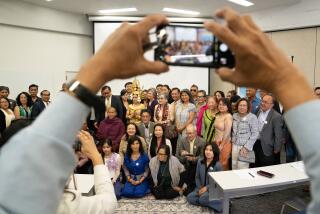Book Review : Artful Lessons for Living in Cambodian Folk Stories
Cambodian Folk Stories From the Gatiloke, retold by Muriel Paskin Carrison from a translation by the Venerable Kong Chhean (Charles E. Tuttle: $15.95; 139 pages)
As I read the charming and wise tales collected in “Cambodian Folk Stories,” one thought kept haunting me: How, oh how, could the culture that created these sublime stories also produce a bloodthirsty political regime that practiced genocide on its own people?
As Muriel Paskin Carrison reminds us in her deeply compassionate postscript to “Cambodian Folk Stories,” Cambodia was “the first great civilization and powerful empire of Southeast Asia whose people created beautiful works of art, literature, and music.” A thousand years ago the Cambodians controlled much of Southeast Asia, including what is now Burma, Thailand, Malaysia and Vietnam. Since the 13th Century, however, the Cambodians have known the ungentle attentions of outsiders: first the Thais and the Vietnamese; then the French and later the Americans; and now the Vietnamese again. And for a brief hideous moment in the aftermath of the war in Vietnam--”the time of peal chur chat , the ‘sour and bitter time’ “--Cambodia’s own leaders engaged in a sustained spasm of self-genocide that resulted in the murders of 3 million people in a nation of 7 million.
A Happier Era
“Cambodian Folk Stories” harks back to a simpler and happier era in Cambodian history. The stories are drawn from the Gatiloke, a collection of folklore of ancient lineage and profound but understated moral purpose. Like the tales of the Hasidic rabbis, the stories of the Gatiloke were employed by Buddhist monks of Cambodia to impart the teachings of their faith. Again like the Hasidic stories of Eastern Europe, these Cambodian folk tales amount to moral instruction by means of simple cautionary tales of ethical conduct and right living in which we can occasionally glimpse an exquisite irony or a sparkling insight. “Freely translated,” says Carrison, “ Gatiloke means ‘the right way for the people of the world to live.’ ”
The Gatiloke is populated with foolish kings and sagacious buffalo boys, scheming courtiers and pure-hearted princesses, rapacious eagles and clever owls. Each story is designed to illustrate a precept of Buddhism in a specifically Cambodian folk setting; each story is given resonance and meaning for the Western reader by Carrison’s thoughtful editorial asides.
Thus, for instance, “The Princess of Amaradevi” depicts the victory of a clever princess over the grand ministers who conspire to betray her husband and then win her hand (and her riches) in marriage--the princess entices each conspirator into stealing a telltale jewel, and then captures each one in a trap filled with warm mud and sticky rice. The moral of the story, according to Carrison: “At a time when most of the world treated women as lowly possessions, Cambodians had ancient traditions of respecting their women as important human beings and treating them as equals.”
Still, there are moments in the Gatiloke that prefigure by a millennium the tragic fate of the Cambodian people. In “Story of Bhikku Sok,” a man from a famine-stricken mountain village makes his way to a town to find food for his family: “When he returned home some time later, the superstitious villagers were afraid of him because he had dared to leave their secluded village and live boldly among the lowland strangers,” the tale goes. And when the villager demonstrates some of the things he had learned about cooking and preserving food, he is accused of black magic--and a gang of hunters is dispatched to kill him and his family with seven razors. Only a single child is spared, and only because he had been sent to the rice fields before the hunters attack.
Foreign Cultures
So, too, did the Khmer Rouge fear and despise any Cambodian who had been exposed to the influences of Western civilization--the slightest taint of alien culture was a death sentence. When the orphaned child in “Story of Bhikku Sok” overhears the boasts of the hunters, we can only think of the murderous hand that will be raised against an entire people in the late 20th Century: “He listened in horror as they spoke about the killings of his mother, his father, his grandparents, his sisters and brothers, his aunts and uncles--the entire family,” says the anonymous storyteller of the Gatiloke story. “He trembled with terror when the hunters grumbled impatiently that one small boy was still alive and no one could find him.”
Errata: The following sentences were misprinted in my recent review of Lincoln Caplan’s “The Tenth Justice: The Solicitor General and the Rule of Law” (Knopf): “Caplan’s book is mostly a brief on the malefactions of the Reagan Administration, and not always a temperate or well-focused one. But ‘The Tenth Justice’ is nonetheless an exceptional book about law for both the lay reader and the lawyer.”


